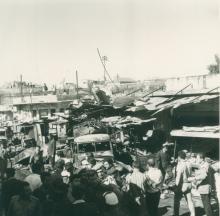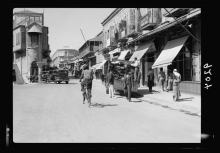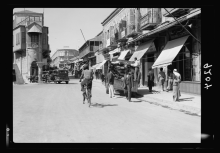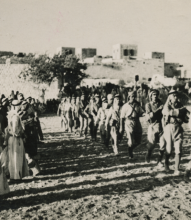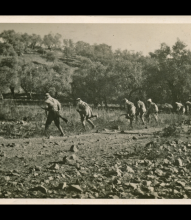On April 15 1936, on the road between Nablus and Tulkarem, Farhan al-Sa'di and a number of his comrades are waiting to ambush a Zionist vehicle with rifles in hand. Shots are fired and a Zionist is killed. This would be the very first bullet of the , and the guerilla war which would exact a heavy toll on British and Zionist forces. It also served as a preface to the general strike that would begin in that same month, which would lead the British government to declare a state of emergency.
The Revolt combined rudimentary weapons and random guerrilla attacks with mass protests and widespread civil disobedience. It ignited the cities and small towns, driving Palestinian leaders to take a quick stand by forming the Arab Higher Committee (AHC ), which comprised all Palestinian forces and factions. Haj Amin al-Husseini , the Grand Mufti of Jerusalem, was elected as its president so that the committee may outline its demands. They aimed to completely end Jewish immigration to Palestine as well as Jewish land acquisition, and to form a national government that is held accountable to a parliamentary council.
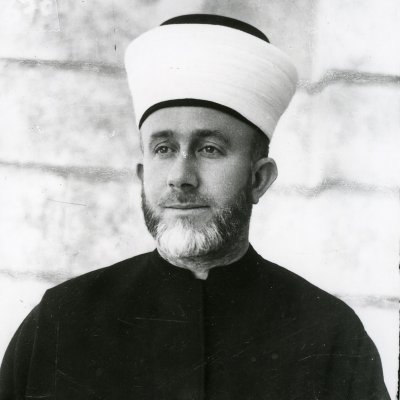
Muhammad Amin al-Husseini was born in Jerusalem. His father, Haj Tahir al-Husseini, married twice: Zainab, with whom he had two sons, Muhammad and Kamel, and Mahbuba, with whom he had eight sons. Muhammad Amin had one son, Salah al-Din, and six daughters: Zainab, Suad, Asma, Nafisa, Jihad, and Amina.
He was educated in Jerusalem and then at al-Azhar Mosque in Cairo. He performed the pilgrimage with his family in 1913, while he was still a young man, and he was called “Haj” until the end of his life.
His father sent him to Istanbul in 1915 to continue his education, but he joined the Military Academy, graduating as a non-commissioned officer. He then joined the Arab Revolt led by Prince Faisal before the end of World War I.
He was appointed in 1918 as special adjutant to the British Military Governor but soon resigned in protest over the pro-Zionist policy of Britain and taught at al-Ma‘arif college in Jerusalem.
He was elected president of the Arab Club in Jerusalem, the first political group in Palestine to publicly reject the Balfour Declaration. In 1920, the British authorities sentenced him to prison in absentia for having led demonstrations that year. He escaped to Karak and from there to Damascus during the Faisal government.
He returned to Jerusalem later that year after having been pardoned by the newly appointed High Commissioner, Sir Herbert Samuel. When his elder brother Kamel died, he succeeded him as Mufti in May 1921. In January 1922 he was appointed president of the Supreme Moslem Council, instituted by the High Commissioner, so Haj Amin came to occupy these two important posts until he was driven out of Palestine in 1937. He displayed great energy and determination in these posts; he led the nationalist movement in secret, being wary of the British authorities. He thus became the most prominent and influential Arab leader in the country. The supporters of Haj Amin were known as al-majlisiyyun (council proponents) in reference to the Supreme Moslem Council (al-Majlis). The opposition to the council was led by Raghib al-Nashashibi.
The Zionists accused him of having incited the al-Buraq/ Western Wall Disturbances of 1929, but the British authorities cleared him of that charge. In 1931, he supervised the convening of the Pan-Islamic Congress in Jerusalem, hoping to mobilize the Muslim world to oppose Zionism, which itself had mobilized its world potential. He chaired the meetings of that congress. That congress firmly established his reputation in the Arab and Islamic spheres. In 1933 he toured a number of Arab countries including Iraq, Kuwait, and Saudi Arabia, urging support for the cause of Palestine, and acted as a mediator to end the fighting between Saudi Arabia and Yemen in 1933.
In 1936, and after some hesitation, he presided over the Arab Higher Committee, which included the leaders of all Palestinian parties and which led the general strike of 1936 and the Great Palestinian Rebellion of 1937–39 to protest the partition plan advocated by the Royal Commission chaired by Lord Peel.
After Arab rebels assassinated Lewis Andrews, British district commissioner for Galilee, in September 1937 soon after publication of the Peel Report, the British Government dismissed Haj Amin from his post as president of the Supreme Moslem Council and decided to arrest all members of the Arab Higher Committee including Haj Amin. He took refuge in the Noble Sanctuary (al-Haram al-Sharif) and then fled to Jaffa and Lebanon from where he continued to lead the revolt until the outbreak of World War II. He escaped from Lebanon and took refuge in Iraq to evade arrest by the French Mandate authorities.
The British government declined to invite Haj Amin to the London Conference of 1939 from which was issued the White Paper of 1939, which Haj Amin rejected. The government did however send an envoy to negotiate with people close to him about the White Paper but British prime minister Winston Churchill, an overzealous supporter of the Zionists, soon aborted these negotiations.
In Iraq, Haj Amin became the focal point of the Iraqi national anti-British movement, which eventually led to the revolt of Rashid Ali al-Kailani.
When the Kailani revolt collapsed in 1941, Haj Amin left Iraq for Iran, and then to Turkey (which refused to grant him asylum) and the Axis Powers, Germany and Italy. Haj Amin spent the war moving between Berlin and Rome and took part in the propaganda war against Britain and France through Arabic radio broadcasts from Axis radio stations.
After the defeat of the Axis powers, Haj Amin attempted without success to seek refuge in Switzerland but was captured by French troops in Germany; he managed to escape. The French authorities turned a blind eye to his “escape” in order to spite London for its role in making France leave Syria and Lebanon after World War II. So, in April 1946, Haj Amin took refuge in Egypt and was a guest of King Faruq. He made Cairo his headquarters because the British authorities would not allow him to return to Palestine.
The Arab League had in 1946 reconstituted the Arab Higher Committee, leaving the post of president vacant. While in Egypt, Haj Amin assumed its presidency and reorganized it. This organization then led the Palestinian national movement during the last years of the British Mandate and opposed the UN Partition Resolution of 1947. During the years 1946–48, Haj Amin led the Palestinian national movement, moving between Cairo, Beirut, and Damascus but not Baghdad or Amman.
When the British Mandate ended, Haj Amin opposed the entry of Arab regular and irregular forces to Palestine to try to prevent partition and the rise of a Jewish state in 1947–48. He asked instead that the Arabs of Palestine be supplied with money and weapons, formed a force called the Holy Jihad made up from local fighters under his leadership, and then organized National Committees in the cities to act for the Arab Higher Committee and called for the formation of a Palestinian Arab Government as soon as the Mandate came to an end. He was also determined to return to Palestine to take charge of all these activities, but the opposition of the governments of Iraq, Transjordan, and Britain prevented the Arab League from agreeing to his plans.
In September 1948, the Arab Higher Committee in Gaza proclaimed the formation of the All-Palestine Government, headed by Ahmad Hilmi Abd al-Baqi, with the support of Egypt and the non-Hashemite Arab countries. Haj Amin presided over the Palestine National Council, held in Gaza, which confirmed the legality of that government. However, because of the collapse of the Egyptian front in October and in November 1948, Haj Amin and the government moved to Egypt and remained there.
After the Nakba and the signing of the armistice agreements between the Arab states and Israel, followed by the annexation of the West Bank by the Hashemite kingdom of Jordan and the placement of the Gaza Strip under Egyptian administration, the role of Haj Amin and the Arab Higher Committee began to diminish and lose influence. Haj Amin remained in Egypt until 1959 and then moved to Lebanon where he settled and spent the remainder of his life. He advocated the liberation of Palestine by force of arms and oversaw the affairs of Palestinian refugees through the two bureaus of the Arab Higher Committee in Damascus and Beirut. He also travelled among the capitals of the Islamic world to garner support for the cause to which his life was dedicated.
Haj Amin al-Husseini was a man of firm and unwavering convictions who never retreated from positions he considered right and just. He played the most important role in Palestinian politics during the Mandate and was keenly attentive to the Arab and Islamic worlds. He sought tirelessly to make the Palestine cause a common concern for these worlds but was unable to bring the Palestinian opposition over to his side. There were many reasons why he failed to organize the Palestinians into a force capable of resisting the Zionist movement, especially during the decisive period when that movement determined to occupy Palestine by force of arms following the UN Partition Resolution of 29 November 1947. That resolution was in any case the result of pressures put on the new and unelected US president Harry Truman, who had succeeded Franklin Roosevelt.
Haj Amin died in Beirut in 1974 and was buried in the Martyrs' Cemetery.
Sources
دروزة، محمد عزة. "مذكرات محمد عزة دروزة: سجل حافل بمسيرة الحركة العربية والقضية الفلسطينية خلال قرن من الزمن (خمسة مجلدات). بيروت: دار الغرب الإسلامي، 1993.
العودات، يعقوب. "من أعلام الفكر والأدب في فلسطين". عمان: د. ن.، 1976.
"الموسوعة الفلسطينية"، القسم العام، المجلد الرابع. دمشق: هيئة الموسوعة الفلسطينية، 1984.
نويهض، عجاج. "رجال من فلسطين". بيروت: منشورات فلسطين المحتلة، 1981.
Abdul Hadi, Mahdi, ed. Palestinian Personalities: A Biographic Dictionary. 2nd ed., revised and updated. Jerusalem: Passia Publication, 2006.
Palestinians escalated their mass strike to encompass all sectors, including municipality workers, with the exception of those working in electricity, water, and general hygiene.1

The Palestinian armed resistance in the Revolt took on every possible form. Palestinians used bombs to blow up police stations, destroy automobiles, and set fire to headquarters and bases. They also attacked Zionist settlements and farms, centering their attacks on Zionist and British communication lines with the use of tools as diverse as nails, explosives, and rifles.2
Village women would send food and water to revolutionaries in the mountains, as well as military equipment smuggled amongst the firewood they carried on their heads.3
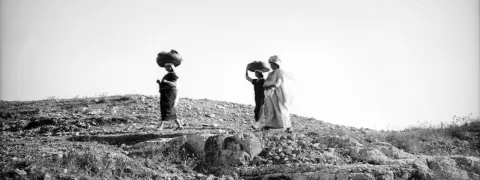
Women also contributed by passing information and intelligence on the movements of enemy forces. Women from the city would communicate with women from the village, who in turn would pass on the information to the revolutionaries in the mountains. By doing so, the women formed what would be called “a circle of communication and intelligence.”4
This mechanism of passing on information was very effective in helping revolutionaries hide, as it utilized coded messages hidden in entertaining musical chants, which later turned into a form of folklore and popular art. One example is the story of Jamila from the village of Anata, who warned the revolutionary Ahmad al-Issawi and a number of his comrades hiding in her village of the coming of a British raid, singing:
“Those who can hear, pray for Muhammad, those who saw, those who stood, those few children, play with the laurel, those who can't jump, pet the cat, jump monkey jump!”5
Every day of the Revolt, women would participate uninterruptedly in resisting the British and Jewish forces. They would engage in physical altercations with British soldiers to help free revolutionaries from their grasp, and would also sabotage British military missions by putting nails under their cars and throwing stones at them.6 They also played an important role in storing and protecting weapons; village women took advantage of home gardens and outdoor kilns, while city women hid them in home water wells.7 Some women would even hide weapons in their loose clothing, which was instrumental in carrying out missions to assassinate informants. One example is that of Shamma al-Hasan, who used to sell fresh yoghurt in Haifa. She carried a gun under her clothing and would transport it from one place to the next until she delivered it to the intended recipient. While she was carrying yoghurt and yelling “Yoghurt! Yoghurt!” the revolutionary would shoot the target and return the gun to Shamma, who would then leave the area while still selling yoghurt.8
Women also took up arms and were trained for direct confrontation with the enemy, for which the women of Tirat Haifa and Ramin were well known. The women of Ramin opened fire on the British when they arrested the ten guards of Abd al-Rahim al-Hajj Muhammad , which they did to make it appear that the fighters were not among the incarcerated, and so the crime could not be proven and charged.9
On May 14 1936, the Arab women of Jaffa assembled and adopted the decisions of the AHC and emphasized the continuation of the strike until they have been given their rights.10 The Jerusalem women's committee released a statement on July 27 1936, which addressed the resilience of the Arabs of Palestine and their struggle, while also saluting those who were either exiled or imprisoned.11 They even took to the streets and used canes to hit vendors who violated the strike. The most well-known of those women was Mu'minah Sultan Masudi.12
In a strategic shift for the Revolt, random attacks and improvised missions were transformed into battles that took on a more organized and effective formation. A few months into the Revolt, the revolutionaries were able to bring down a plane and destroy three cars in the battle of Bala'a. This was followed by the destruction of three British planes and many individual losses among British forces.
Soon, however, the blow came from within, when the Committee announced the dissolution of the strike. This announcement did not mean the end of the Revolt, but rather that the Palestinians would be without a unified national leadership. This caused different parties and revolutionaries to work independently in their attacks and in leading their battles.13
In the following two years, feda'iyyin (freedom fighters) and revolutionaries succeeded in many direct attacks against Jewish forces and British authorities. They purposefully targeted members of police, settlements, Jewish properties, and British authorities with bombs. They also worked on destroying train tracks, government roads and buildings, cutting off telegraph communication, assassinations, and blowing up fuel lines. In the first year of the Revolt, the number of attacks by revolutionaries reached 4,076. Amongst these attacks, 1996 of them were against Jewish individuals, while 895 attacks targeted Jewish properties in different cities. The attacks that were directed towards the British army and police were against 795 individuals, and against 380 means of transportation.
At one point during the Revolt, the revolutionaries were able to take control of most of the main roads connecting many key cities. They also gained control of mountainous areas, and were able to move about freely in broad daylight in places such as Nablus.14
Changes on a global scale likely played a significant role in aborting the Great Revolt in 1939. The outbreak of World War II, the state of exile of most Palestinian leaders, the fall of the Revolt's leadership in the field of battle one after the other—all these developments, put together, were enough to wear down the revolutionaries and cause the Revolt to dissipate, finally ending in the battle of Tarshiha.15 Still, this popular struggle continues to serve as a Palestinian reference point and source of inspiration for resistance.
SELECTED BIBLIOGRAPHY
- 1Kabaha, Mustafa Dawud. Thawrat 1936 al-Kubra Dawwafi'uha wa In'ikasatiha [The 1936 Great Revolt, Its Motivators and Effects]. Nazareth: Manshurat Maktabat al-Quds, 1988, p. 51.
- 2Khalifa, Ahmad. Al-thawra al-Arabiyya al-Kubra fi Filastin al-Riwaya al-Isra'iliyya al-rasmiyya [The Great Arab Revolt in Palestine, the Official Israeli Narrative]. Beirut: Institute for Palestine Studies, 1989, p. 18.
- 3Abdul Hadi, Fayha'. “Adwar al-mar'a al-filastiniyya fi al-thalathinat 1930 – al-musahama al-siyasiyya lil mar'a al-Filastiniyya [The role of the Palestinian Woman in the Thirties, the Political Participation of the Palestinian Woman]. Al- Bira: Markaz al-Mar'a al-Filastiniyya lil-Abhath wa al-Tawthiq, 2005, p. 33-34.
- 4Ibid, p. 46.
- 5Ibid, p. 107.
- 6Ibid, pp. 49-52.
- 7Ibid, pp. 83-85.
- 8Ibid, p. 107.
- 9Kabaha, Mustafa, and Nimer, Sarhan. Sijil al-Qada wa al-Thuwar wa al-Mutatau'een Lithawrat 1936-1939 [A Record of Leaders, Revolutionaries, and Volunteers in the Revolution of 1936-1939]. Kuft Qare': Dar al-Huda, 2009, p. 298.
- 10Khartabil, Wadi'a. “Dhikrayat wa Muthakarrat Qadura Khartabil, Bahthan ‘an al-amal wa al-Watan, Situn ‘Aman min Kifah Imra'a fi Sabil Qadiyyat Filastin [Memories and Memoirs of Qadura Khartabil, In Search of Hope and a Homeland, Sixty years of a woman's struggle for Palestine].” Beirut: Bisan Publishing House, 1995, p. 75.
- 11Ibid.
- 12Kabaha, Mustafa, and Nimer, Sarhan, Record of Leaders, Revolutionaries, and Volunteers, p. 723.
- 13Kanafani, Ghassan. Thawrat 36 - 39: Khalfiyyat wa Tafasil wa Tahlil [The 1936 – 1939 Revolt: Background, Details, and Analysis]. Jerusalem: Matba'at al-Nasir, al-Wikala al-Filastiniyya lil-Sahafa wa al-Nashr.
- 14Ibid.
- 15Ibid.
